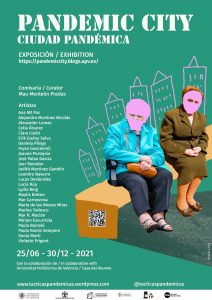Just when we are about to let our guard down, an online exhibition reminds us of the transformation that the pandemic city has undergone and the consequences that derive from it.
An unusual exhibition of public art and transmedia analyses and traverses the new pandemic city, intervening in its main spaces that are basically exterior.
Curated by the feminist artist Mau Monleón Pradas, and organised by the collective Tácticas Pandémicas of the Universitat Politécnica de València, the unusual exhibition entitled Pandemic City / Ciudad Pandémica includes the work of 26 young artists, most of them women, from different European countries such as Spain, France and Germany. From this first-world European cultural perspective and taking the specificity of the city as an object of analysis and transformation, 116 works of artistic creation have been produced over a period of 4 months in which the city has been used both as a support and as the content of the action. Also, the exhibition has counted on the participation of a team of professional women in graphic design and web programming, to configure the image and interface of this “pandemic city”.
Pandemic City / Ciudad Pandémica is a public art and transmedia exhibition presented online in the context of the current pandemic by COVID-19. The exhibition seeks to articulate a debate around the changes in the city’s public space, highlighting those open spaces that link to each other. These are urban areas that have often retained their public utility but whose uses have mutated to redefine their forms and interrelationships.
Thus we find the public bench, the wasteland, public transport and the park as the main spaces in this exhibition, while other places such as the street, the square, the cycle path, the bridges, the sea, the school playground, the river or the internet, help us to trace the territory of a new city which, after not so distant events such as “the Spanish flu”, has once again been touched by the sword of Damocles.
This persistent threat of a danger in the city focuses precisely on public health and is intimately related to fundamental aspects such as social relations and the family, which have been clearly impacted, suffering the main blow. The economy that promotes hyper-capitalist politics has also been hit by this onslaught. But it so happens that, at the same time that the global economy is faltering and the capitalist system is showing its great aporia, the concern for social justice and environmental responsibility; the concern for life itself; the planet earth and the care of people is re-emerging with greater force.
Pandemic City / Ciudad Pandémica is part of this concern, taking as a precedent the previous exhibition entitled Pandemic House (2020), whose reflection was based on the state of alarm and the first confinement of people. Initially, in Spain we were locked up on 14 March 2020 while the WHO declared the pandemic that same week – the coronavirus disease (COVID-19) was notified for the first time in Wuhan (China), on 31 December 2019.
At that time the curator Mau Monleón Pradas presented the exhibition Pandemic House, which dealt with the creation of a common house based on the personal experience of each of the selected artists. After that first confinement, the city is once again practicable today in Spain and in other countries, and open spaces become the indispensable territory for a “new normality”: this has been the new starting point.
Pandemic City / Ciudad Pandémica starts from the investigation of the different expressive languages of art and especially public and transmedia art, to generate various interdisciplinary works of art that use different languages and techniques such as animation; public art; artivism; body art; embroidery; photomontage; digital photography; installation; performance; illustration; net.art; performance; painting; street-art; subvertising; or video art, among others.
Also novel and relevant is the glossary of terms that converges in this exhibition and gives critical content to the proposal. From this glossary, organised by the concepts of art; the concepts of the exhibition itself; and the concepts of the new pandemic city, one can navigate through the works and the exhibition proposal, getting to know those words that invade and concern us, and learning the meanings that circulate in the new public sphere. “Aerosols”; “isolation”; “social anxiety”; “antigens and asymptomatics” are just some of the new realities that have emerged in the popularly called “pandemic city”.
For the artists, the pandemic is experienced in this exhibition in the present tense, and the city – that collection of buildings and streets whose dense and numerous population is usually engaged in non-agricultural activities – has become the pandemic city: a city that suffers the consequences and adapts to COVID-19.
From the collectivity of a group of people who live in the same territory and share certain circumstances, we wanted to contribute this reflection and this space for debate on the new meaning of our cities, transformed as a result of the pandemic. Working from ecofeminism; the methodologies of the south; and in a transmedia way, we have accepted the challenge of “overcoming pandemic fatigue” by locating the weaknesses of this new besieged city and combating these weaknesses in order to put into practice our strengths as users of the new cities.
Fundamental to this has been the association and promotion of the collective work of the artists, who have gone beyond the inevitable individualism imprinted in their “digital genetics”. This is why the exhibition invites various participatory actions in which everyone can collaborate, such as the debate forum on instagram @tacticaspandemicas.
In short, Pandemic City / Ciudad Pandémica suggests that this new pandemic city, born under the influence of capitalist individualism, should not only be capable of producing group immunity to COVID-19, but should also be able to overcome social injustice and restore environmental health.

